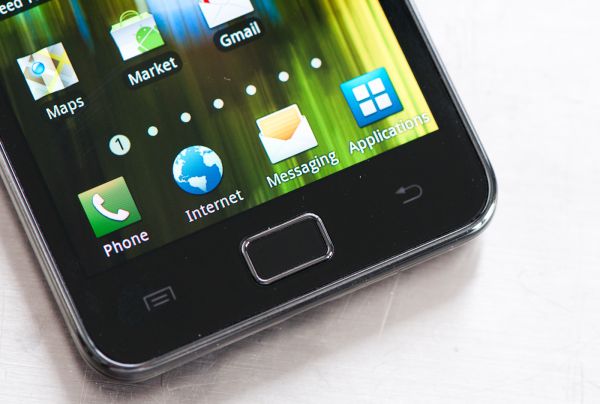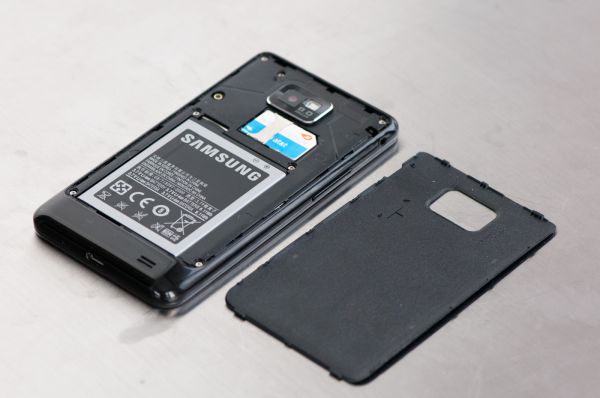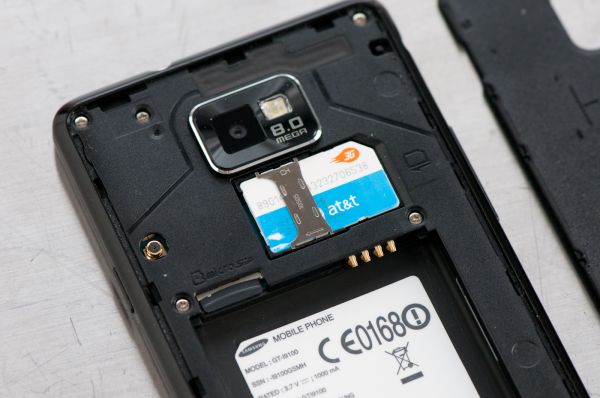Samsung Galaxy S 2 (International) Review - The Best, Redefined
by Brian Klug & Anand Lal Shimpi on September 11, 2011 11:06 AM EST- Posted in
- Smartphones
- Samsung
- Galaxy S II
- Exynos
- Mobile
Physical Impressions
The button arrangement on SGS2 continues the trend set by the international version of the original SGS, and eschews the search button, instead going with (left to right) menu, home, and back. Of course, regional variants are going to have different button arrangements, but this three-button approach seems to be a mainstay of the international market. When I hand the phone to most people, there’s usually a bit of confusion about what the home button does, and many mistake it for an optical or capacitive trackpad. Instead, the button is just that - a button. They’re backlit, and there are options to define backlighting behavior in the stock ROM - when in the dark, for a few seconds, and so forth.
Update: You can alternatively search by pressing and holding menu. Thanks everyone!
I have to be honest that continuing to shun the search button confuses me. Not just because not having it means we can’t run kwaak3 and get to console without lots of work, but because not having it made me realize how much I use it. Thankfully almost everywhere that I’d use the search button there’s a contextual shortcut - menu, then search. It’s just an added button press in the occasional spot, which can be alien if you’re used to having that button.
As I mentioned earlier, the battery cover is one piece of plastic which pries off and is held on with clips. It isn’t particularly sturdy, so thankfully getting the battery cover off isn’t a harrowing experience. Underneath is the SGS2’s large 6.11 Whr battery, microSD slot, and SIM slot. The microSD card can’t be accessed without a battery pull, and the card clicks in and clicks out. You can get the SIM out without a battery pull, however, and word has it you can even change SIMs without rebooting despite the prompts. At the very top is a ribbon antenna which is pretty evident, and below that is the camera module with adjacent LED flash.
There’s really not much to say about the phone with the battery cover off, everything is perfect here, and it’s clear just how much of the device’s internal volume is dedicated to the SGS2's relatively large 6.11 Whr battery.
Overall the SGS2’s in-hand feel is much better than its predecessor - it’s incredible how much a different back texture and 1.6mm of reduced waistline can make a phone feel. Where I waver back and forth is the weight department. The competition has largely gone in a design direction that employs metal and thus results in heavier devices. As a result, SGS2’s light weight seems to imply a certain level of cheapness where really there is none. I guess that’s the problem - even though SGS2 has metal internally for structure, the exterior is entirely plastic, and that’s what’s ultimately the material that sets user perception. The good thing is that though it feels light, SGS2 has solid build quality.
There are no rattles when the vibrator is going, no flimsy parts that might snap off or break (like the old microUSB door), and few places where dirt can encroach. There’s also very little flex. It’s impressively solid after you get over the hurdle that is its light weight.
| Physical Comparison | ||||||
| Apple iPhone 4 | HTC Sensation | Samsung Galaxy S | Samsung Galaxy S 2 | |||
| Height | 115.2 mm (4.5") | 126.3 mm (4.97") | 122.4 mm (4.82") | 125.3 mm (4.93") | ||
| Width | 58.6 mm (2.31") | 65.5 mm (2.58") | 64.2 mm (2.53") | 66.1 mm (2.60") | ||
| Depth | 9.3 mm ( 0.37") | 11.6 mm (0.46") | 9.9 mm (0.39") | 8.49 mm (0.33") | ||
| Weight | 137 g (4.8 oz) | 148 g (5.22 oz) | 119 g (4.20 oz) | 115 g (4.06 oz) | ||
| CPU | Apple A4 @ ~800MHz | 1.2 GHz Dual Core Snapdragon MSM8260 | 1.0 GHz Hummingbird S5PC110 Cortex A8 | 1.2 GHz Exynos 4210 Dual Core Cortex A9 | ||
| GPU | PowerVR SGX 535 | Adreno 220 | PowerVR SGX 540 | ARM Mali-400 | ||
| RAM | 512MB LPDDR1 (?) | 768 MB LPDDR2 | 512 MB LPDDR2 | 1 GB LPDDR2 | ||
| NAND | 16GB or 32GB integrated | 4 GB NAND with 8 GB microSD Class 4 preinstalled | 16 GB NAND with up to 32 GB microSD | 16 GB NAND with up to 32 GB microSD | ||
| Camera | 5MP with LED Flash + Front Facing Camera | 8 MP AF/Dual LED flash, VGA front facing | 5 MP AF, VGA front facing | 8 MP AF/LED flash, 2 MP front facing | ||
| Screen | 3.5" 640 x 960 LED backlit LCD | 4.3" 960 x 540 S-LCD | 4.0" 800 x 480 SAMOLED | 4.27" 800 x 480 SAMOLED+ | ||
| Battery | Integrated 5.254Whr | Removable 5.62 Whr | Removable 5.92 Whr | Removable 6.11 Whr | ||




















132 Comments
View All Comments
Mugur - Tuesday, September 13, 2011 - link
Well, for most Android devices I've tried (I currently own 3), if you just leave them doing nothing overnight (even with wifi on on some of them, but no 3G/HSDPA, no GPS etc.) the battery drain is like 2-3%. Of course, if some app or push email or an updating widget wakes them, the drain could reach 20-25%.You just have to play a bit with the phone and find out what is mostly consuming your battery, even get one of the "green" apps on the Market. Through experimentation, I'm sure most people (excluding the really heavy users) will get 50% more time of the battery.
wuyuanyi - Monday, September 12, 2011 - link
It must be the final answer for my pending problem.my GS II has this problem and I has been very annoyed.the CPU current produce a EMI on the output circuit ,for the BT earphone DOESN'T play such hiss and noisy.apprecite it to solve my problem rather than suspect whether it is my own case. but the next question is how to solve it ? can we manual fix the shield or , generate a noisy that is against the noisy --with reverse wave?hehe
sorry for my poor ENGLISH
awesomedeleted - Monday, September 12, 2011 - link
This is a fresh copy of my current phone...Samsung Infuse 4G...which came out in May. I hate the newer Galaxy S round home button thingy too. What's so special, the name?awesomedeleted - Monday, September 12, 2011 - link
Although I now notice a few small differences in hardware, such as 1.2Ghz Dual-core A9 vs. my Infuse's 1.2Ghz Single-core A8, and the 1GB RAM.supercurio - Monday, September 12, 2011 - link
Infuse 4G is a Galaxy S "repackaged" with a Galaxy S II look, screen and probably camera sensor for AT&T.bmgoodman - Monday, September 12, 2011 - link
So I understand that the audio quality of this phone is a step down from the original galaxy. My question is how big a step down? For a non-"audiophile" who just wants to connect the headphone jack into the AUX port on his OEM car stereo to listen to his variable bit rate MP3 (~128 bps IIRC) music collection, is this something that's likely to disappoint? Is it a notable shortcoming for a more typical music fan?supercurio - Monday, September 12, 2011 - link
No doubt cars are in general a noisy environment.Furthermore its very rare to find cars benefiting from good speakers and implementation, resulting in far from linear frequency response, left/right imbalance, resonance in other materials etc :P
Trained ears or sensible people are capable of detecting subtle difference in sound like nobody can imagine ^^ but I don't think it will Galaxy S II DAC issues described will make a noticeable difference when listening to music while driving a car for most people.
Note: I have no idea how was the original Samsung Galaxy phone on this regard, but its a regression over Galaxy S.
Headphones.. that's something else because even cheap ones (price doesn't matter) can provide some low distortion levels and let your perceive fine details.
Deusfaux - Monday, September 12, 2011 - link
It is there and does work, speaking from experience with a Nexus S.Deusfaux - Monday, September 12, 2011 - link
An HTC I used did it best though, with integrating the feature right into the browser settings. No special URL strings needed to access functionality.aNYthing24 - Monday, September 12, 2011 - link
But isn't there a version of the Tegra 2 that is clocked at 1.2 GHz? It's going to be at that clock speed in the Fusion Grid table.t